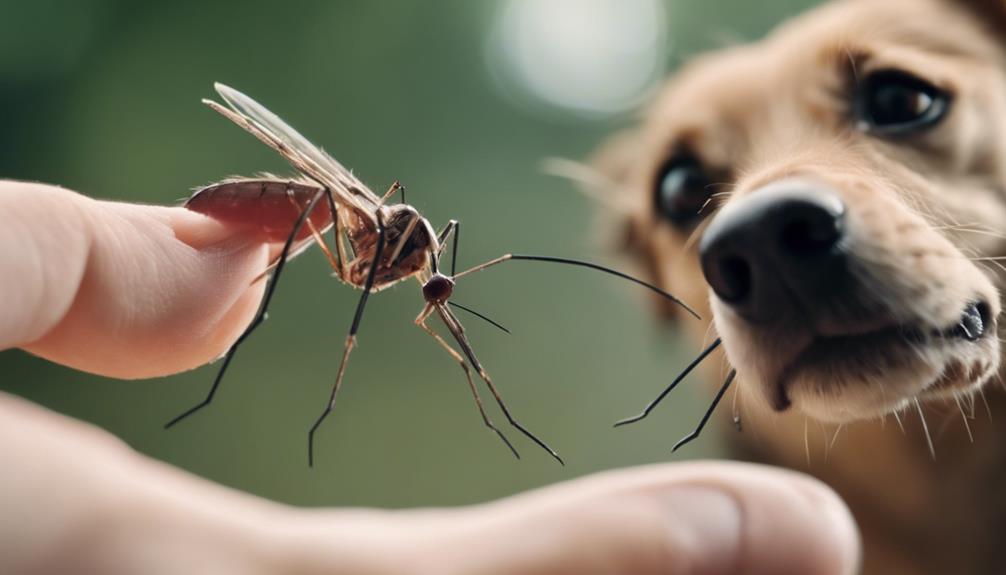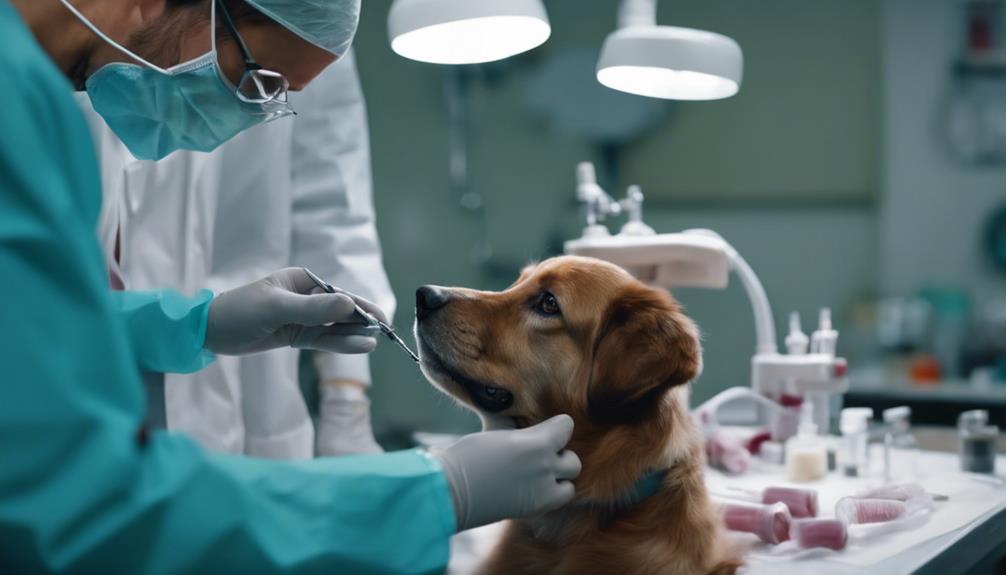Heartworms in dogs present a serious health concern that necessitates attention and understanding. The implications of this parasitic infection extend beyond mere discomfort, affecting vital organs and potentially leading to life-threatening complications.
By grasping the intricacies of heartworm disease, individuals can proactively safeguard their pets. Addressing causes, symptoms, prevention strategies, and treatment options is paramount in ensuring the well-being of beloved canine companions.
Stay tuned to uncover valuable insights into navigating the realm of heartworms in dogs and fortifying a defense against this prevalent yet preventable threat.
Key Takeaways
- Heartworm disease can affect various animals and is transmitted by mosquitos.
- Regular screening and preventative medication are crucial for managing heartworm infections.
- Treatment involves injections to eliminate adult heartworms, with surgery for severe cases.
- Permanent damage can occur even after successful treatment, highlighting the importance of prevention.
Heartworm Basics
Heartworms, parasitic organisms that target the heart and lungs of various animals, pose a significant health threat to dogs and other susceptible species. These parasites, which can infect not only dogs but also foxes, coyotes, wolves, cats, ferrets, sea lions, and even humans, are transmitted through mosquito bites. Once inside a host, heartworms mature, mate, and reproduce, eventually causing severe health issues.
Symptoms of heartworm infection in dogs can range from lack of exercise and coughing to weight loss, difficulty breathing, and, in extreme cases, death. Regular screening for heartworms using antigen and microfilariae tests is crucial for early detection and treatment.
Timely intervention, including multiple injections of melarsomine and, if needed, surgical procedures, can help manage heartworm infections effectively.
Animals at Risk
When considering the susceptibility to heartworm infection, various animal species, including dogs, cats, and wildlife like foxes and coyotes, are at risk due to their exposure to mosquito bites.
Animals at Risk:
- Dogs: Domestic dogs are the most common host for heartworms due to their proximity to humans and outdoor activities.
- Cats: Cats are also susceptible to heartworm infection, but they are considered atypical hosts and the disease is harder to detect in them.
- Wildlife: Foxes and coyotes living in endemic areas are at risk of heartworm infection, contributing to the spread of the disease in nature.
Transmission by Mosquitos

Mosquitos play a crucial role in the transmission of heartworm disease to susceptible animals. When mosquitos bite an infected animal, they pick up microfilariae, the baby worms of heartworms. These microfilariae develop into infective larvae within the mosquito. Subsequently, when the mosquito bites a healthy animal, it transmits these larvae, which can mature into adult heartworms if left untreated.
| Transmission by Mosquitos | |
|---|---|
| Process | Description |
| Mosquito bites infected animal | Picks up microfilariae |
| Microfilariae develop into infective larvae | Within the mosquito |
| Mosquito bites healthy animal | Transmits infective larvae |
Life Cycle of Heartworms
The life cycle of heartworms involves a complex series of stages within different hosts, ultimately leading to potential infection in susceptible animals.
- Mosquito Transmits Larvae: A mosquito carrying heartworm larvae bites an animal, depositing the larvae onto the skin.
- Migration Through Tissues: Larvae enter the host through the bite wound and migrate through tissues, maturing into infective larvae.
- Reach the Heart and Lungs: Mature heartworms travel through the bloodstream to the heart and lungs, where they reproduce and continue the life cycle.
Understanding this intricate life cycle is crucial for effective prevention and treatment strategies against heartworm disease in animals.
Spread of Heartworm Disease

Heartworm disease poses a significant threat to animals worldwide due to its increasing prevalence and ease of transmission. The disease is diagnosed in every state and is spreading rapidly.
Any dog in contact with mosquitos is at risk of infection, as mosquitos play a crucial role in transmitting heartworms. These insects pick up baby worms by feeding on infected animals and then deposit infectious larvae on a dog's skin when biting, even when indoors. This efficient transmission mechanism contributes to the widespread distribution of heartworm disease.
As a result, it is essential for pet owners to take preventive measures to protect their dogs from this potentially fatal infection.
Risk Factors for Dogs
Identifying the factors that increase a dog's susceptibility to heartworm infection is crucial for effective prevention and management strategies.
Risk Factors for Dogs:
- Geographic Location:
- Dogs living in regions with higher mosquito populations have an increased risk of heartworm transmission.
- Outdoor Exposure:
- Dogs that spend a lot of time outdoors, especially during peak mosquito activity periods, are at higher risk of being bitten by infected mosquitoes.
- Lack of Prevention:
- Dogs that are not on a regular heartworm prevention regimen are more likely to contract the disease if bitten by an infected mosquito.
Symptoms in Infected Dogs

Understanding the various symptoms that can manifest in dogs infected with heartworms is essential for timely detection and appropriate management of the disease. While some dogs may not show any signs, others may exhibit symptoms that indicate a severe infection. Common symptoms include lack of exercise tolerance, coughing, and lethargy. In more advanced cases, weight loss, difficulty breathing, and even death can occur. Regular screenings and early detection are crucial in ensuring the well-being of your dog.
| Common Symptoms | Severe Symptoms |
|---|---|
| Lack of exercise | Weight loss |
| Coughing | Difficulty breathing |
| Lethargy | Death |
Diagnosis Methods
Utilizing diagnostic tests is essential for accurately detecting and confirming the presence of heartworm infection in dogs. The following methods are commonly used by veterinarians for diagnosing heartworm disease:
- Antigen Test: This blood test detects specific proteins produced by adult female heartworms in the bloodstream, providing a reliable indicator of infection.
- Microfilariae Test: By examining a blood sample under a microscope, veterinarians can identify the microfilariae (baby heartworms) circulating in the bloodstream, aiding in the diagnosis of heartworm disease.
- X-rays and Ultrasound: Imaging techniques such as X-rays and ultrasound scans can help visualize the heart and lungs, allowing for the detection of heartworms and evaluation of the extent of damage caused by the infection.
Treatment Overview

Treatment for heartworm disease in dogs is crucial in effectively combating the infection and ensuring the well-being of the infected animal. Once a positive heartworm test is confirmed, close evaluation by a veterinarian is necessary to determine the best course of action.
The primary treatment involves multiple injections of melarsomine, a medication designed to kill adult heartworms. In severe cases where dogs have developed caval syndrome, surgical intervention may be required.
Following treatment, it is essential for dogs to be put on monthly prevention medication to avoid re-infection. It is important to note that even after successful treatment, permanent damage to blood vessels can occur, highlighting the importance of prevention strategies to safeguard the long-term health of the animal.
Melarsomine Injections
Administering melarsomine injections is a critical component of the treatment protocol for heartworm disease in dogs. This medication is specifically designed to kill adult heartworms, helping to eliminate the infestation and improve the overall health of the infected animal.
When undergoing melarsomine treatment, there are several key points to consider:
- Injection Protocol: The injections are typically administered deep into the lumbar epaxial muscles on the dog's back, and the treatment involves a series of injections over a specified period.
- Rest and Observation: Following each injection, it is crucial to restrict the dog's activity to reduce the risk of complications and allow for proper healing.
- Monitoring: Regular veterinary check-ups are essential to monitor the dog's progress, assess treatment effectiveness, and address any potential side effects promptly.
Surgical Intervention

When melarsomine injections alone are insufficient to address severe cases of heartworm disease, surgical intervention may be necessary to alleviate life-threatening complications and improve the dog's overall prognosis.
Surgical removal of adult heartworms is typically recommended for dogs with advanced infections, particularly those suffering from caval syndrome, a condition where worms block blood flow within the heart. This procedure, known as adulticidal treatment, involves directly extracting worms from the heart and pulmonary arteries through an incision in the jugular vein.
While surgical intervention poses risks, such as potential complications from worm fragments breaking off, it is crucial in critical cases where immediate relief is needed to prevent further damage and increase the chances of a successful recovery.
Post-Treatment Care
After successful treatment for heartworm disease, diligent post-treatment care is essential to ensure the dog's recovery and prevent re-infection. It is crucial to follow specific guidelines provided by the veterinarian to support the dog's healing process and maintain their overall well-being.
Post-treatment care may include:
- Restricted Activity: Limiting exercise and physical exertion to prevent complications during the recovery period.
- Regular Check-ups: Scheduled follow-up appointments to monitor progress and assess the effectiveness of the treatment.
- Preventative Medication: Administering monthly heartworm prevention medication as directed to safeguard against future infections.
Importance of Prevention

Prevention of heartworm disease is paramount in safeguarding the health and well-being of dogs against this potentially fatal infection. Implementing preventive measures can significantly reduce the risk of heartworm transmission and the need for expensive treatment. Year-round prevention is highly recommended, as it is more convenient and cost-effective compared to managing the disease post-infection.
Several preventative options, including monthly medications, topical solutions, and injections, are available to protect dogs from heartworms. It is essential to consult with a veterinarian to determine the most suitable prevention method based on the dog's lifestyle and risk factors.
Conclusion
In conclusion, understanding the causes, symptoms, prevention, and treatment options for heartworm disease in dogs is essential for pet owners.
By recognizing the risk factors associated with this parasitic infection and prioritizing preventative measures, individuals can protect their beloved companions from the potentially severe complications that can arise.
Timely diagnosis and intervention, along with post-treatment care, play a crucial role in addressing heartworm infestations effectively and ensuring the health and well-being of dogs.




